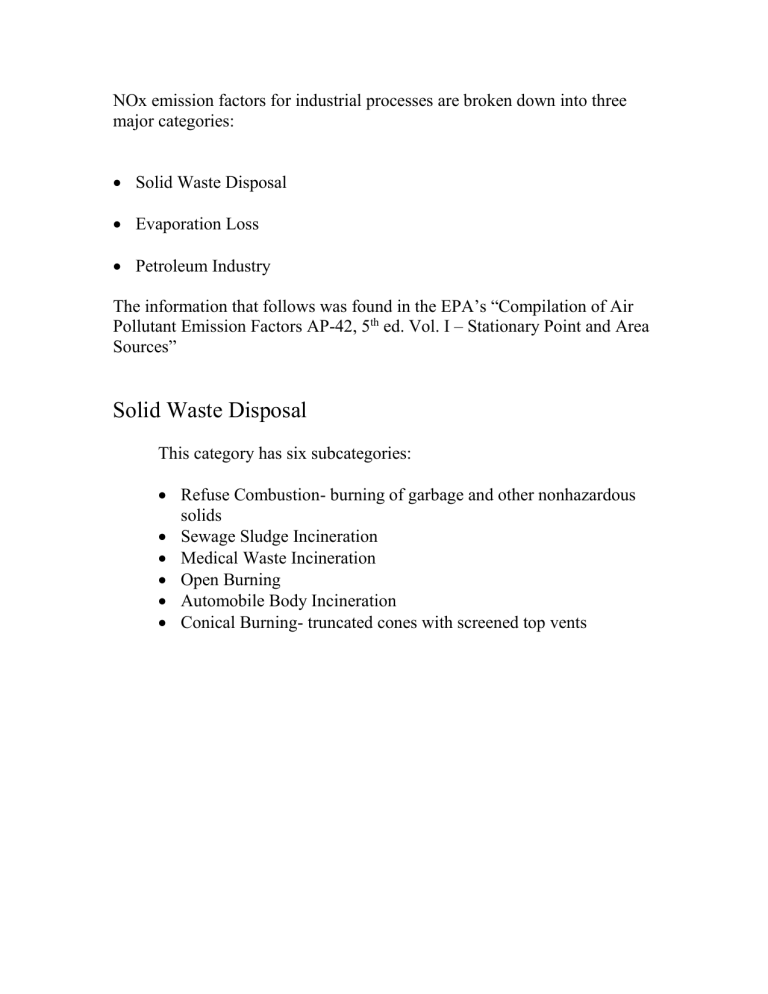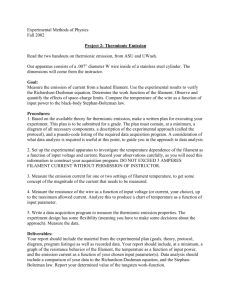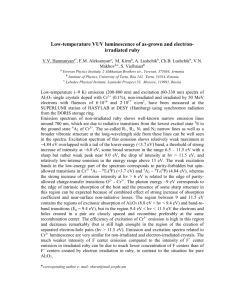industrial processes nox emission factors

NOx emission factors for industrial processes are broken down into three major categories:
Solid Waste Disposal
Evaporation Loss
Petroleum Industry
The information that follows was found in the EPA’s “Compilation of Air
Pollutant Emission Factors AP-42, 5 th ed. Vol. I – Stationary Point and Area
Sources”
Solid Waste Disposal
This category has six subcategories:
Refuse Combustion- burning of garbage and other nonhazardous solids
Sewage Sludge Incineration
Medical Waste Incineration
Open Burning
Automobile Body Incineration
Conical Burning- truncated cones with screened top vents
Refuse Combustion
This type of combustion uses five main different combustors and nine other combustors which are used for other than municipal waste.
Table 1. Emission Factor for Mass Burn Rotary Waterwall Combustors
Pollutant Uncontrolled kg/Mg lb/ton
NOx 1.13 2.25
Calculated with a heating value of 10466 J/g.
Should be used for estimating long term, not short term, emission levels, this applies particularly to pollutants measured with continuous measuring emission monitoring systems.
Table 2. Emission Factor for Mass Burn Refractory Combustors
Pollutant Uncontrolled
NOx kg/Mg
1.23 lb/ton
2.46
Calculated with a heating value of 10466 J/g.
Should be used for estimating long term, not short term, emission levels, this applies particularly to pollutants measured with continuous measuring emission monitoring systems.
Table 3. Emission Factor for Modular Excess Air Combustors
Pollutant Uncontrolled
NOx kg/Mg
1.24 lb/ton
2.47
Calculated with a heating value of 10466 J/g.
Should be used for estimating long term, not short term, emission levels, this applies particularly to pollutants measured with continuous measuring emission monitoring systems.
Table 4. Emission Factor for Refuse-Derived Fuel-Fired Combustors
Pollutant Uncontrolled
NOx kg/Mg
2.51
Calculated with a heating value of 10466 J/g.
Should be used for estimating long term, not short term, emission levels, this applies particularly to pollutants measured with continuous measuring emission monitoring systems.
Table 5. Emission Factor for Modular Starved-Air Combustors
Pollutant Uncontrolled lb/ton
5.02 kg/Mg lb/ton
NOx 1.58 3.16
Calculated with a heating value of 10466 J/g.
Should be used for estimating long term, not short term, emission levels, this applies particularly to pollutants measured with continuous measuring emission monitoring systems.
Table 6. Emission Factor for conical Burners Without Controls
Type of Waste NOx
Municipal refuse kg/Mg
2.50 lb/ton
5.00
Wood refuse 0.50 1.00
If you want to find out what volume of pollutant you have, you can use the following conversion factors to determine this value at 7% O
2
.
Combustor Type
All but RDF
RDF
Table 7. Conversion Factors for NOx emissions
Divide kg/Mg lb/ton kg/Mg lb/ton
By
7.70 X 10
-3
1.54 X 10
-2
9.54 X 10
-3
1.89 X 10
-2
To Obtain ppmv ppmv ppmv ppmv
Trench
Table 8. Emission Factor for Combustors other than Municipal Waste
Combustor Type NOx kg/Mg lb/ton
Industrial/commercial
Multiple chamber
Single chamber
Wood
Rubber tires
Minicipal refuse
Flue-fed single chamber
1.50
3.00
1.00 2.00
2.00 4.00
ND ND
ND ND
1.50 3.00
Flue-fed (modified)
Domestic single chamber
Without primary burner
With primary burner
5.00 10.00
0.50
1.00
1.00 2.00
Sewage Sludge Incinerators
There are three main types of incinerators used in sewage sludge burning. They and their emission factors are as follows:
Table 9. Sewage Sludge Incinerators Emission Factor for NOx
Incinerator Type a
NOx b kg/Mg lb/ton
Multiple Hearth
Uncontrolled
Fluidized Bed
Uncontrolled
Electric Infrared
Uncontrolled
Controlled (Venturi/impingement)
2.50 5.00
0.88 1.70
4.30
8.60
2.90 5.80 a units are pollutants emitted per dry sludge burned b uncontrolled emission factors apply to all air pollution control device types
Medical Incinerators
There are three types of medical waste incinerators. The first type, the controlled air incinerator, only has one emission factor for NOx which is 1.78 kg/Mg (3.56 lb/ton) for uncontrolled emissions. The second type, the rotary kiln incinerator, has several different ways of PM control. The table below only list a few. The third type, the excess air incinerator, there was no data given.
Pollutant
Table 10. Rotary Kiln Medical Waste Incinerator emission factor
Uncontrolled SD/FF SD/Carbon High Energy
Injection/FF Scrubbers kg/Mg lb/ton kg/Mg lb/ton kg/Mg lb/ton kg/Mg lb/ton
NOx
SD – Spray dryer
2.31 4.63 2.63 5.25 2.45 4.91 2.04 4.08
FF – Fabric filter
The high energy scrubbers are of the venturi type with a convergent/divergent section. A liquid, usually water, is injected into the gas stream upstream of the throat. The flue gas impinges on the liquid stream in the converging section. As the gas passed through the throat, the the shearing action atomizes the liquid into fine droplets. The gas then decelerates through the diverging section, causing more contact between particles and liquid droplets. The liquid is then removed by cyclone, demister, or swirl vanes.
Open Burning
For open burning, which is done either in an open drum or in a field, there are only tw emission factors given for this. The NOx emission factors for municipal refuse is 3 kg/Mg (6 lb/ton). The other emission factor is for automobile components which is 2 kg/Mg (4 kg/Mg). The emission factor for automobile components takes into account the burning of upholstery, belts, hoses, and tires burned together.
Auto Body Incineration
This is the area where the total car is burned (tires removed). It takes approximately 30-40 minutes to burn two cars simultaneously. The data given is based on
113 kg (250 lbs) of combustible material on stripped car body. There are two emission factors for this type of burning. The first is with no air pollutant control devices installed, uncontrolled burning. The emission factor for this is 0.05 kg/car (0.1 lb/car). The second is with an afterburner attached to the incinerator. With the afterburner installed, the emission factor for NOx is reduced to 0.01 kg/car (0.02 lb/car).
Evaporation Losses
The only found for evaporation losses was those for drum cleaning. The factors are given in two categories. The first, uncontrolled, has an emission factor of 0.89 g/drum
(.002 lb/drum). The controlled has an emission factor of 0.018 g/drum (0.00004 lb/drum).
These values are in terms of the weight of pollutant released per drum burned.
Petroleum Industry
The first, boilers and process heaters was given under the fuel combustion heading. The remaining are broken down into several subcategories per type. There is currently no data for the fluid coking units and delayed coking units. The former which is made up of uncontrolled and electrostatic precipitator and CO boiler . The remaining emission factors are as follows:
Table 11. Emission Factors for Petroleum Refineries a
Process NOx
Fluid Catalytic Cracking units
Uncontrolled
kg/1000 L fresh feed
lb/1000 bbl fresh feed
Electrostatic precipitator and CO boiler
kg/1000 L fresh feed
lb/1000 bbl fresh feed
Moving-bed cracking units d
kg/1000 L fresh feed
lb/1000 bbl fresh feed
Compressor engines
Reciprocating engines
kg/1000 m3 gas burned
lb/1000 ft3 gas burned
Gas turbines
kg/1000 m3 gas burned
lb/1000 ft3 gas burned
Blowdown systems
Uncontrolled
kg/1000 L refinery feed
lb/1000 bbl refinery feed
Vapor recovery system and flaring
kg/1000 L refinery feed
lb/1000 bbl refinery feed
Vacuum distillation column condensers c
Uncontrolled
kg/1000 L refinery feed
lb/1000 bbl refinery feed
Controlled (vented to heater or incinerator)
0.204
(0.107 to 0.416)
71.0
(37.1 to 145.0)
0.204
b
(0.107 to 0.416)
71.0
b
(37.1 to 145.0)
0.014
5.00
55.4
3.4
4.7
0.3
Neg
Neg
0.054
18.9
Neg
Neg
Neg
a Numbers in parentheses indicate a range of values observed Neg = negligible b May be higher from the combustion of ammonia c If refinery feed rate is known rather than vacuum feed rate, assume vacuum feed rate
is 36% of refinery feed. Refinery feed rate is the crude oil feed rate to the atmospheric
distillation column.






